Silicon Motion SM2256 SSD Controller Preview: TLC for Everyone
by Kristian Vättö on June 17, 2015 8:15 AM EST- Posted in
- Storage
- SSDs
- TLC
- Silicon Motion
- SM2256
AnandTech Storage Bench - The Destroyer
The Destroyer has been an essential part of our SSD test suite for nearly two years now. It was crafted to provide a benchmark for very IO intensive workloads, which is where you most often notice the difference between drives. It's not necessarily the most relevant test to an average user, but for anyone with a heavier IO workload The Destroyer should do a good job at characterizing performance. For full details of this test, please refer to this article.
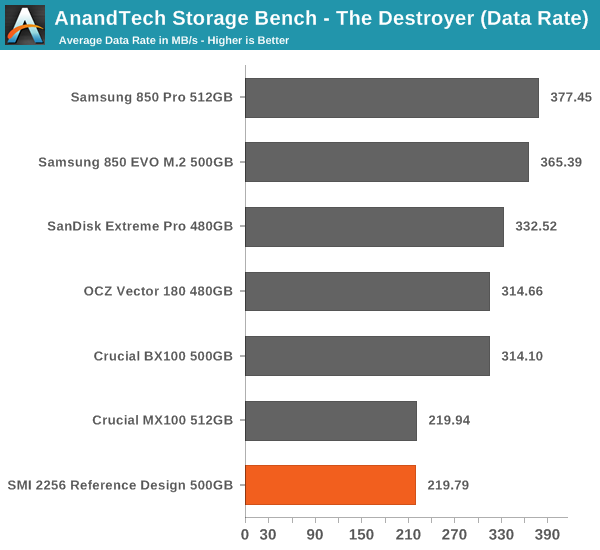
Under a very intensive IO workload, the SMI 2256 is a mediocre performer. Average data rate is high, which suggests good performance at large IO sizes, but the average latency is considerably higher than what MLC drives and the 850 EVO have to offer. Then again, TLC is slower than MLC and 3D TLC, and that's a fact that no controller can get around. Ultimately TLC drives, at least at first, will be more aimed towards typical client workloads anyway, which aren't really illustrated by The Destroyer.
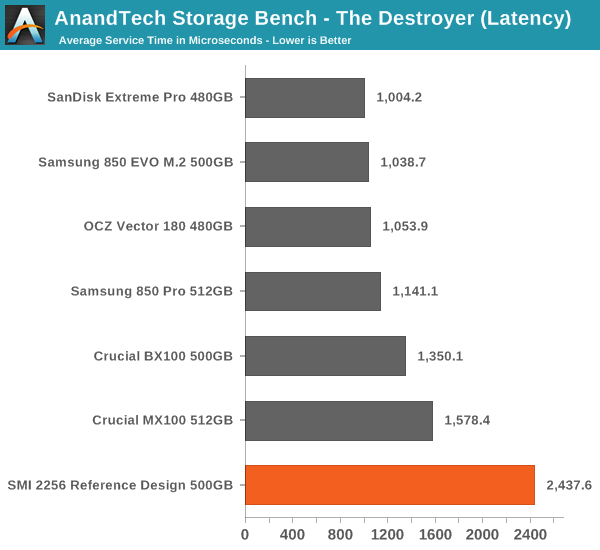
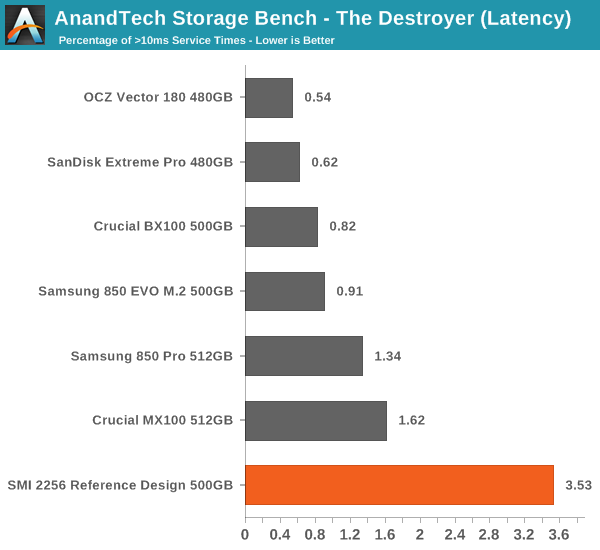
The number of high latency IOs is substantially higher than in the SM2246EN, but at 3.5% it's not alarming especially because the share of >100ms IOs is very moderate and not any worse than MLC drives.
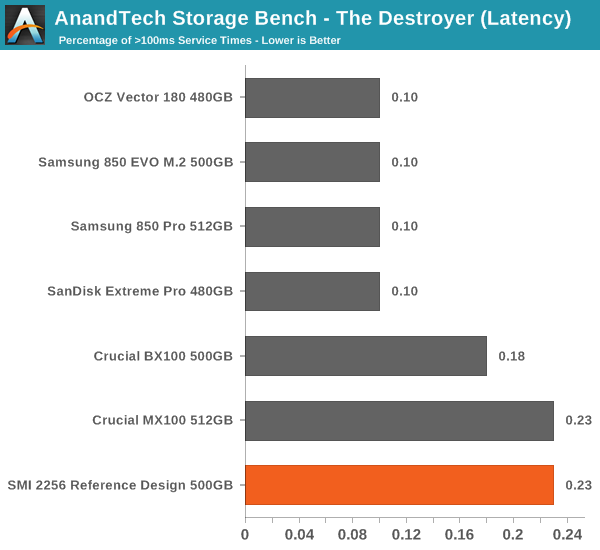
One of the inherent issues with TLC that nobody is talking about is increased power consumption, which our testing proves. TLC requires a higher number of program pulses to program the correct voltage, resulting in longer total program time as well as increased power draw. In addition, SLC caching means that all data essentially gets written twice, which obviously adds power draw despite SLC programming being much more power efficient.
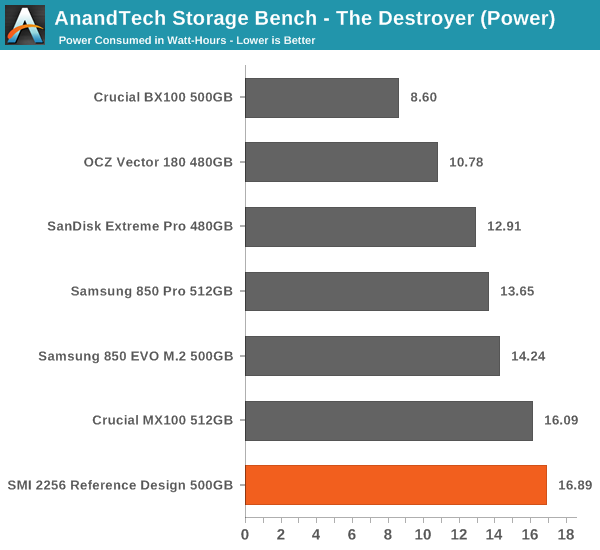










34 Comments
View All Comments
watzupken - Wednesday, June 17, 2015 - link
Looking at the state of the Samsung 840, I am still not convinced with TLC based SSDs. With value in mind, SSD is also walking down the path of cheap but unreliable storage solutions from my opinion. E.g. mechanical drives used to last a very long time, but not now even though they are cheap.leexgx - Saturday, June 20, 2015 - link
the problem with 840 and 840 evo is just that its not refreshing the cells when it should be (the data is still retained even if its slow doing it) SSDs problem with retaining data is an issue towards end of life but that happens on all SSDs (more a concern for commercial use then consumer drives)der - Wednesday, June 17, 2015 - link
Wow great!RU482 - Wednesday, June 17, 2015 - link
IS THAT....A HAIR?i7 - Wednesday, June 17, 2015 - link
Looks like it to me.KAlmquist - Wednesday, June 17, 2015 - link
"OEMs can't price their TLC drives similarly to the MLC ones and expect it to be a good sale."Agreed. If you look at the prices of Samsung's 850 series, it's around $0.90 per GB of nand cells plus a fixed cost of $30. So you can get an MLC model for better performance at $0.45/GB of capacity, or a TLC model with lower performance at $0.30/GB of capacity. If that type of pricing is adopted by other SSD manufacturers, then TLC becomes very tempting; otherwise not so much.
The other thing about the 850 line is that the relatively large cell size associated with 3D Nand appears to have eliminated the problem with data deterioration that we saw on the 840 EVO. So TLC will become more attractive next year when 3D Nand becomes available from other manufacturers.
nwarawa - Wednesday, June 17, 2015 - link
10% my tush. Try 20%+. Considering I can get a good MLC 256GB-class drive like a BX100 right now for around $100, if they can't get a similar TLC drive under $80, I won't even give it a second glace.revanchrist - Wednesday, June 17, 2015 - link
TLC is going to be real cheap. Tigo, a Chinese 3rd-party ssd manufacturer has announced its tlc ssd based on Silicon Motion controller and SK Hynix nand chips last week, available in quantity up to 2TB. They've only disclosed the price of the 240gb model, which is RMB 399, roughly 65 USD. FFS that could translate to 260 USD for a 1TB model OMG.revanchrist - Wednesday, June 17, 2015 - link
The controller is exactly SM2256 and the nand is 16nm 128Gb TLC from SK Hynix.anactoraaron - Wednesday, June 17, 2015 - link
OFF TOPIC: Wow you guys must have had some serious issues with the LG G4 for it to be 2+ weeks past release and still no review.I'm guessing you were about to publish the issues you have had with the device (missed taps/unresponsive screen, slow charging/heat, lag/stutter, etc) and basically not recommend anyone purchase it and you were 'advised' by LG to not publish this until they have had a chance to fix those issues, which according to Android Central will be in the next 3-4 weeks. I just can't recall a review of a flagship device that wasn't out within 2 weeks of release (unless it was a Sony device since they won't comp anything to you guys to review).
I don't see the point of waiting, because even with the issues I personally have (unresponsive screen/lag/stutter) the G4 is still a solid device.
This isn't a knock on you guys - you do probably the most unbiased and thorough reviews. The delay on this review is just starting to smell a bit to me.